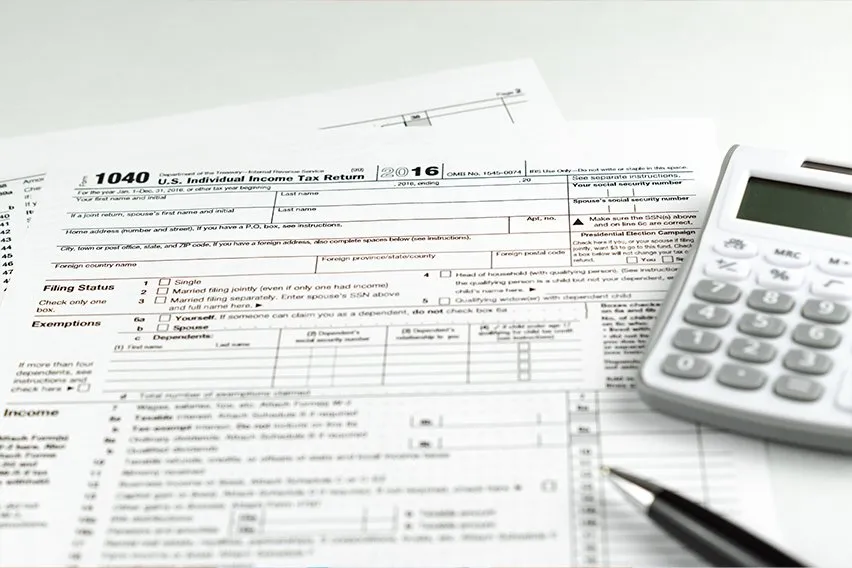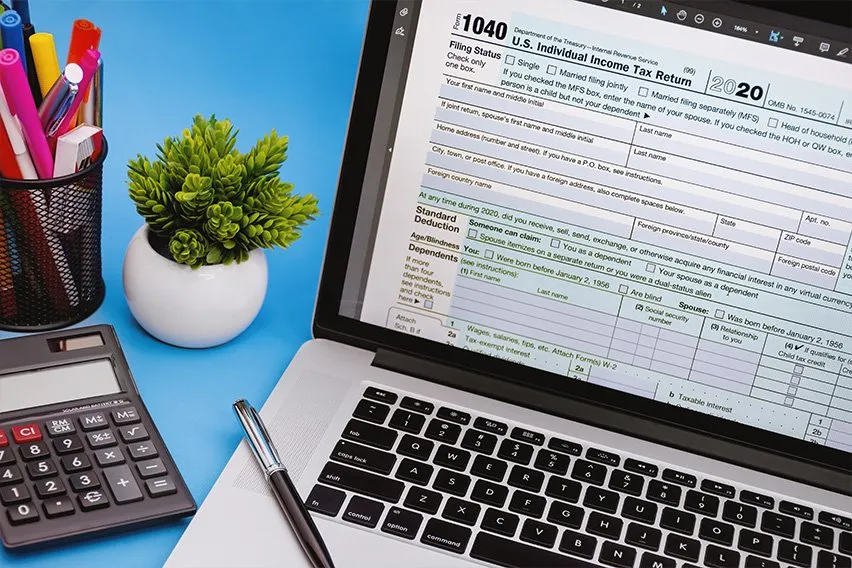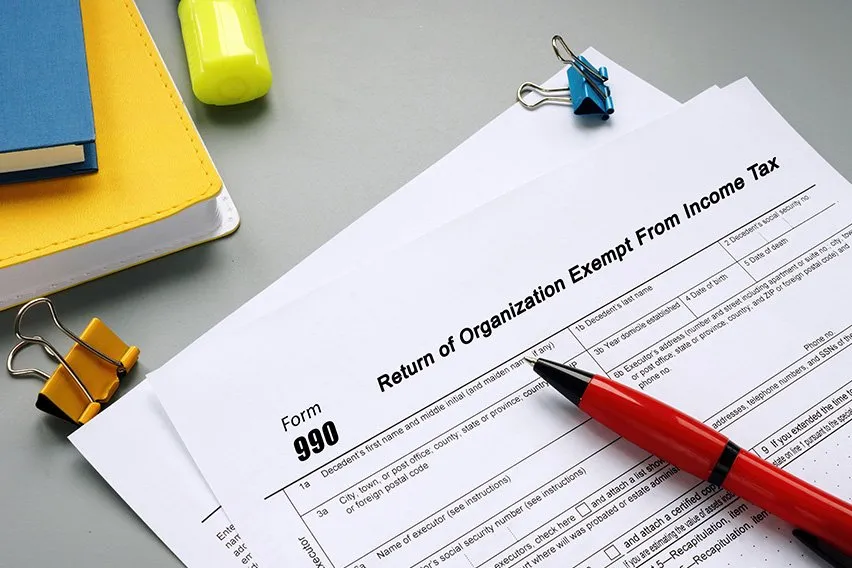W2 vs W4: The Difference Between W2 and W4 IRS Forms

Throughout the tax preparation process, you can expect to send and receive several forms to the IRS. A few of these forms, such as W-2s and W-4s, are submitted through your connection to an employer. Both employers and employees are responsible for understanding which tax forms are necessary to file.
In this article, we’ll highlight a simple comparison: W-2 vs W-4. Although the distinctions between these two forms are relatively easy to understand, knowing how to use and leverage each one will help you get a handle on your tax situation.
Here’s What We’ll Cover:
What are the Sections on W-2 Forms?
What are the Sections on W-4 Forms?
Calculating Personal Withholdings
W2 vs W4: Understanding the Business Impact
Is Anyone Exempt from the W-2 and W-4 Process?
How W2 and W4 Forms Affect Your Tax Refund
What is Form W-2?
A W-2 form is an annual wage and tax statement that is issued by an employer. It reflects money earned over the last twelve months and how much payroll tax has been covered.
In regards to the conversation around W2 vs W4, the W-2 recaps past events and payments.
A W-2 doesn’t make adjustments for the current tax season. Instead, it quickly summarizes the amount of money in different categories.

Who Should Complete Form W-2?
Any business that has employees is required to complete W-2s for the individuals they employ and pay. This applies whether the employer is a small business, large corporation, or civic organization.
How Can You Locate a Completed W-2 Form?
An employer sends W-2 forms to each employee. A paper copy is usually sent to a recipient’s home address. Many times, employees can locate this document in an employment portal or via email.
When Can Employees Access the W-2 Form?
Form W-2 is sent either online or via mail in January or February of the year after the reported year. For example, you can expect to receive your W-2 for the 2023 calendar year in early 2024.
According to the Social Security Administration, employers have a W-2 form deadline of January 31. An employer must officially file the form and notify you, the employee, of its existence.
How Do You Complete a W-2 Form?
If you are an employee or an individual, you cannot prepare this particular tax form on your own. Your employer must send it to you so that you can legally complete your tax return.
If you are an employer or a business owner, refer to the IRS website. There are instructions on the back of each PDF copy of the W-2 form, as well as answers to common questions.
Should you need tax advice or additional assistance with E-filing, contact the IRS customer service line toll-free at 866-455-7438.
What is the Purpose of a W-2 Form?
A W-2 serves two primary functions in regards to taxes:
- Form W-2 tells the IRS how much each individual earned in tips, wages, and compensation.
- Form W-2 tells the IRS how much an individual has already paid in payroll taxes.
This form makes it easy to find the exact monetary amounts required to understand personal tax obligations.
Access a Sample W-2 Form
If you are an employer looking for a template to report employee wages, the IRS posts this information publicly. Visit the IRS website and download the PDF copies of Form W-2.
The IRS hosts a few different pages for which you are responsible. This includes:
- Copy A–for the Social Security Administration
- Copy 1–for State, City, or Local Tax Department
- Copy B–filed with an employee’s Federal Tax Return
- Copy C–for an employee’s personal records
- Copy 2–filed with an employee’s State, City, or Local Tax Return
- Copy D–for the employer
What are the Sections on W-2 Forms?
When comparing W2 vs W4, it’s helpful to understand the information that you can expect to find on each form. Below are the main categories that the Internal Revenue Service requires on each W-2.
Taxable Gross Income
Gross income is the amount of money that each employee makes prior to taxes and deductions. A W-2 includes this income information to show an employee’s tax liability.
Tips, Wages, and Compensation
Total income can be different from the compensation amount on a W-2. This is because of non-taxable or pre-tax earnings. An example is money that goes to a 401(k), which is not subject to taxes at the time of deposit.
Federal Income Tax
A W-2 also highlights the amount of federal income tax that an employee has paid throughout the year.
Social Security Tax
Other tax deductions are present on a W-2. For instance, you’ll find Social Security and Medicare deductions. Although this information is included per paycheck, the W2 makes it easy to see as one annual amount.
Employer Information
The IRS needs certain data about each employer, including the Employer Identification Number. You can also locate the employer’s address for tax filing purposes.
State Income Taxes
Each W-2 includes an individual’s state of residence, which dictates the amount of state income tax. The total amount of collected state tax from the previous year is included on each W2.
What is a W4 Form?
Now that we’ve discussed the W-2, let’s take a closer look at the difference between this and a W-4.
W-4 forms are usually required upon hire, and they inform an employer about how you would like to handle tax deductions, dependents, and withholding allowances.
This form is sometimes referred to as the Employee’s Withholding Allowance Certificate.
Who Should Complete a W-4 Form?
Every employee who works for a business should submit a W-4 form during the first month of employment. Doing so ensures that your tax forms are complete and that your income tax liability is accurate. Employers rely on the directions that you provide on Tax Form W-4.
If you have multiple employers, submit a W-4 for each of them. In the same way that you can expect to receive separate W-2 forms, you can also expect that each employer needs to have these facts on file.
Where Can You Find a W-4 Form?
Many times, you can locate a W4 form in your onboarding paperwork, which is delivered in person or via email. If for some reason your company doesn’t provide this automatically to employees, it’s easy to locate a blank W-4 on the IRS website.
Download your own copy of this tax withholding form to have on file and print as needed.
How Do You Complete a W-4 form?
To complete your W-4 form, simply fill out each field. You should ensure that all of your personal contact details (including your Social Security Number) are up to date and accurate. By doing so, both your employer at the IRS have more details about your employment, tax allowance, marital status, and work arrangements.
What is the Primary Purpose of W-4?
The purpose of IRS form W-4 is to provide your employer with directions about how to handle your tax withholding. Your employer will use this data to determine:
- Federal income taxes per paycheck
- Social Security and Medicare deductions per paycheck
- Any extra withholdings you wish to have taken on your wages
Not only does the information you provide change the net pay you receive on each paycheck, but it also determines how you or your accountant will file taxes at the end of the year.
Sample W-4 Form
This article serves as a helpful resource for completing a W-4 form, but if you need to put this insight to immediate use, download a sample W-4 from the IRS website.
The downloadable form also comes with detailed explanations for both business owners and employees. Additionally, you can learn more about how this information is used during tax season.
What are the Sections on W-4 Forms?
The W2 vs W4 conversation is not complete without providing more information on what fields you can expect on a W4. Below are the sections that the IRS asks all employees to submit.
Employee Information
Tax forms require basic contact and identifying information, such as your address and Social Security Number (SSN). Having this information on a W-4 also helps your employer verify your identity.
Job Status
The IRS Form W-4 provides a series of directions if you work multiple jobs. You’ll have the option to select whether you’re married filing jointly, which can affect your tax withholding status.
Marital Status
Combined income has a drastic impact on a household’s holistic tax situation, which is why you must include these details on Form W-4. This section also applies if your spouse is self-employed or owns their own business.
Deductions
Employees have the final say when it comes to how much tax is deducted by employers.
You have the right to make a tax allowance for yourself and members of your family by claiming deductions through your W-4.
It is not the responsibility of employers, however, to make sure that each individual claims enough money in federal, state, or local taxes. As a rule of thumb, try to claim the lowest number of deductions possible on your W-4 to minimize what you owe at tax time.

Calculating Personal Withholdings
As an employee, you might want to ensure that both your W-2 and W-4 are correct, based upon the amount you should be paying in taxes according to your income level. Follow these steps:
- Visit the IRS filing website
- Access the Tax Withholding Calculator
- Perform a “paycheck checkup” to see how much you should be paying as an employee, individual, or head of household
- Compare the results to your W-2 and W-4 periodically and at tax filing time to maximize potential tax deductions for W-2 employees
As we discuss W2 vs W4, it’s also important to know how these two pieces work in tandem. Calculating your deductions and then verifying that they are correct each year is one of the most obvious ways that this happens.
W2 vs W4: Understanding the Business Impact
Whether you’re an employee, small business stakeholder, or corporate business tax preparer, it’s crucial to understand the impact of W-2s and W-4s.
These forms can affect anyone’s standing in the eyes of the government. Remember that both a W-2 and W-4 can have an impact on the following.
- Personal tax liability
- Corporate tax responsibility
- Legality for small business operations
- Tax status for family and dependents
- Dependent information for health insurance purposes
Is Anyone Exempt from the W-2 and W-4 Process?
There are some situations in which you may not need to submit both forms.
- Small business owners who operate as sole proprietors may not need to submit their own W-2 and W-4 forms. Income earned through a sole proprietorship can be reported as self-employed business income.
- Independent contractors do not need to provide Form W-4 to take on new work. Instead, they may be asked to submit different forms, such as the W-9 for work eligibility.
- Individuals who earn less than a certain amount in wages throughout the year may not be required to report the income, although they may still need Form W-4 upon hire.
How W2 and W4 Forms Affect Your Tax Refund
The reality is, if you work as an employee in the United States, you are responsible for paying your annual tax bill. Most often, this payment takes place incrementally as part of the standard paycheck process. In the event that you pay too much or too little, these forms provide a record of that.
Just as employees can’t be paid without a W-4, filers can’t complete their tax prep without a W-2. Delays in completion of these documents may affect your ability to file and pay on time.
Always work ahead of time to prepare your tax documents or work with a qualified tax preparer.
More Resources on Tax Forms
- What Is A W-2 Form? Tips for Employers on Completing Employee Tax Documents
- Preparation of Tax Invoice
- How to Calculate Withholding Tax
- 7 Tax Terms US Entrepreneurs Should Know
RELATED ARTICLES

 Top 12 Tax Deductions for Photographers (2025)
Top 12 Tax Deductions for Photographers (2025) Real Estate Tax Deductions Every Business Should Know
Real Estate Tax Deductions Every Business Should Know 10 Tax Deductions for Cleaning Businesses
10 Tax Deductions for Cleaning Businesses Construction Tax Deductions for Builders and Contracting Businesses
Construction Tax Deductions for Builders and Contracting Businesses Nonprofit Tax Deductions for 501(c)(3) Organizations
Nonprofit Tax Deductions for 501(c)(3) Organizations Five Easy Ways to Tackle Tax Season When You're Self-Employed
Five Easy Ways to Tackle Tax Season When You're Self-Employed